It’s a funny thing how nature works. Last year we had one of the worst droughts in recorded Texas history, and this year we have some of the best wildlife viewing. In fact, 2011 was so empty of caterpillars, butterflies, and other insects that I had great concern for many of our birds, spiders, reptiles, and other wildlife that are dependent on such invertebrates. But this year, after having a reasonable amount of fall and winter rain, we’ve seen an amazing number of caterpillars of all species and with them a tremendous explosion of butterflies and moths. What that means is that we’ll also have lots of baby birds this season, all things considered, and hopefully lots of other creatures. Needless to say, I’m having fun in the wildlife garden – so much to watch!
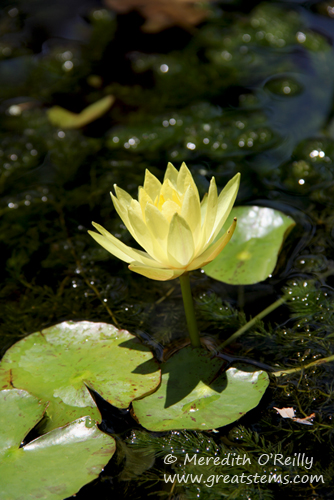 Yellow Water Lily
Yellow Water Lily
This spring has marked a number of firsts for our relatively young garden (I’m going to call it young until it has reached its fifth birthday). Our native Yellow Water Lily is blooming at last. I have waited such a long time for it to do so, though to be fair, it’s certainly possible that it has bloomed without me knowing it. My White Water Lily still hasn’t bloomed yet, as far as I know, but I shall remain hopeful!
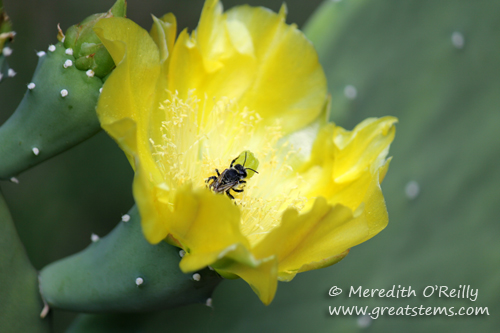 Spineless Prickly Pear
Spineless Prickly Pear
We were getting worried that our Spineless Prickly Pear would never bloom, but lo and behold, it’s in bloom right now. Sure enough, bees and flies and other insects are getting drunk on that delicious Opuntia nectar!
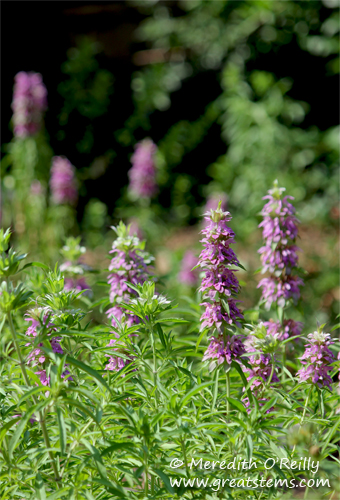
Horsemint
Horsemint, Coreopsis, Black-eyed Susan, and Pincushion Daisy are all in bloom in the garden for the first time. Were those in seed mixes I’d spread around? Or did the birds deliver them? I’d think the first, except that Horsemint and Coreopsis also happen to be growing at the entrance to our subdivision. Hmmmm. The other two are probably just all me.
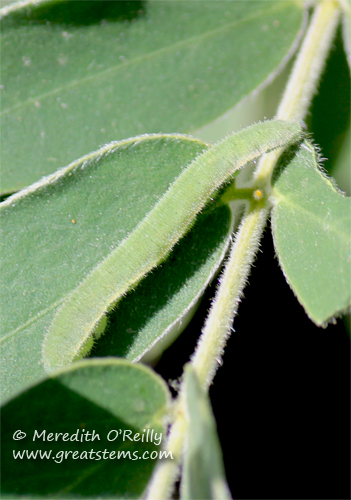
Sleepy Orange caterpillar — I love how it blends with the fuzzy Lindheimer’s Senna leaves
Caterpillars I’ve longed for but hadn’t yet seen munching on the plants we’d planted for them are at last here. With luck, they’ll return as adults to lay more eggs. Pipevine caterpillars, previously present only from eggs brought home on nursery plants, have officially appeared as the result of a visiting female Pipevine Swallowtail. Sleepy Orange caterpillars have been munching on our Lindheimer’s Senna, but with all the other Sulphur butterflies fluttering about, I expect there will be more.
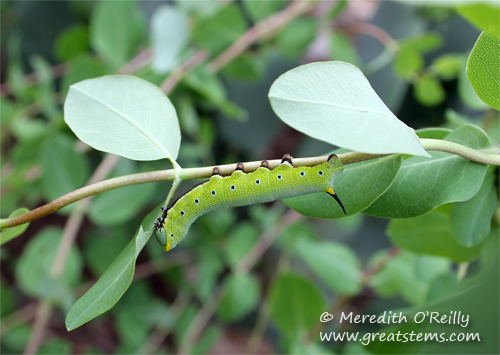
Snowberry Clearwing caterpillar on White Honeysuckle
Butterfly caterpillars aren’t the only ones in great numbers. Snowberry Clearwing caterpillars, complete with the “horns” consistent with their family, have been happily grazing on the White Honeysuckle Shrub. Lots of unnamed but equally welcome moth caterpillars have been seen in trees, on shrubs, on grasses, on veggies, and perennials. That means it should be a good food year for bats and owls and swallows and the like!
The Monarchs and Queens have returned, as have the Black Swallowtails, I report with relief. I’ll feel much better once I see Giant Swallowtails and Tigers again, along with other Swallowtail species of which I am quite fond. And I think we’ve all been impressed by the showing of Red Admirals this year! Painted Ladies, Buckeyes, Question Marks, Checkerspots, Gulf Fritillaries – oh the list goes on.
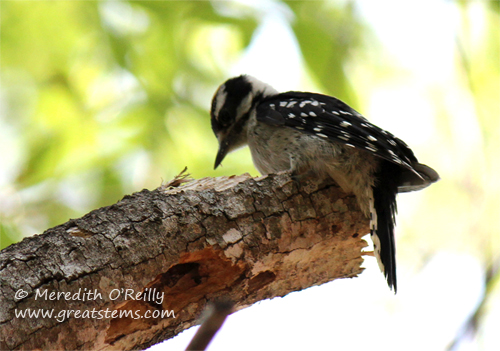
Downy Woodpecker collecting insects
Our Mama Eastern Screech Owl returned to our backyard, and last night I saw an owlet shyly peering down at me from its nesting box. Baby birds are starting to fledge right and left, and we’re watching parent birds teaching their young how to find food. The toads are singing their nightly mating calls. And today for the first time, I watched a Downy Woodpecker feed insects from an old limb to another Downy Woodpecker on a nearby branch. Cute as can be! It’s a good spring. Thank goodness!
You always find caterpillars so easily! I have to admit it took me a while to figure out why lots of caterpillars meant that bats would have enough to eat — I’ve never seen a bat eat a caterpillar! Must have been a long day. 🙂
What a great spring – I love seeing all the wildlife in the garden! Glad you guys had some rain this winter!
I had to go look up the snowberry clearwing butterfly and found it was what I call the hawk moth. They are one of the nicer moths. Moths seem to have interesting larvae but mostly boring adults. However, it seems our phoebes love them and we love the phoebes so all is well.
I probably could have made that more clear, Alan! 🙂
Thanks, Indie — we so desperately needed it, especially to save our remaining trees.
Moths definitely make up a major food source in the ecosystem, so they are valuable, even if they don’t have the colorful interest that butterflies have. Of course, since most moths fly at night, it’s to their advantage to not stand out that much!
I know what you mean – I was so worried about no butterflies last year, but then I’ve seen them all over – the admirals loved the red-tipped photinia in the neighbor’s yard, the Monarchs and Queens have actually been visiting my Gregg’s Mistflower (a first), and the Gulf Fritillaries went ballistic laying eggs (of course a bunch then died because of lack of food even though this is the first year that my passionflower has bloomed and actually looked good). I’ve never noticed so many wrens; and I swear I saw a new Downy Woodpecker the other day – it was male and usually RJ is pretty okay with pictures being taken while this one was super flighty.
The only downside so far is the number of doves that have been congregating at my bird feeders – they’ve even figured out how to get seed from the feeder for the small birds and have been emptying it out as well. I’ve now taken to only putting a quarter cup in in the morning, and then again in the evening when I see the cardinals and chickadees out looking for food.
Great pictures! It does look like the wildlife is enjoying your garden. Good Job! I so badly want to plant a Dutchman pipevine. I read that only certain varieties attract butterflies. Do you know if that is true?
I have seen any caterpillars yet but we’ve had a lot more butterflies than we normally do in late spring and tons of birds. Great blog! Love the frogs in the banner photo.
Oh, I know that scenario with doves quite well! I eventually had to resort to a cage around the tube feeder to keep them from eating all the food. Now I have a “manageable” number, but the house finches and blue jays are now the big eaters!
Hi, Steph. I very much like the White-Veined Dutchman’s Pipevine because it stays nice and low and is very easy to grow. The pipevine you definitely want to avoid is the Giant Pipevine, because it actually kills off the caterpillars — it is considered a population sink.
Thank you, Casa Mariposa! It really has been a great wildlife year so far — I can’t wait to see what visits next! I’m off to check out your blog now — Meredith
I took several pics of fritillary caterpillars munching on my pansies in March. Had to research to identify, but anxious to learn more. Bought first milkweed plant late summer. Lots of doves at my feeders. Didn’t know they were so agile. Had to get a caged feeder to help out smaller birds.
Carol, keep up the great work in caring for wildlife! I know what you mean about the doves — we’ve had to be clever, too!